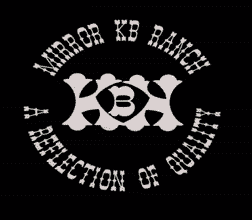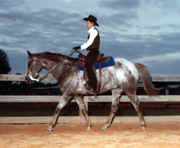 |
Mirror KB Articles
|
 |
Mirror KB Articles
|
Mirror KB Equine Article Series
Evaluating Your Mare’s Potential as a Broodmare
You see them everywhere. Frolicking in the neighbor’s corral, cavorting
across the pasture at the breeding farm down the road, or dashing around the
paddocks at the neighborhood stable. There is nothing more enjoyable than
watching a vigorous foal kicking up its heels, unless it’s a foal of your own.
One that you bred yourself, from your own mare, by a stallion of your own
choosing.
Raising a foal is the ambition of many horse owners, and you’ve probably
been flirting with the idea for some time. A foal that will one day draw the
attention of the show judge, winning top honors at halter, then going on to a
variety of pleasure classes as it matures into a beautiful mount. This doesn’t
have to be an illusive dream, after all you think you have a pretty nice mare.
Skillful handling can bring out the full potential of your foal, but it
cannot put something there that never was there to begin with. With this
realization, you’ve begun to contemplate whether or not you should even think
about breeding the mare you’ve been trail riding. Will your mare produce the
type of foal you want? How do you evaluate her potential?
Investing in horse flesh is always a gamble. But by evaluating your mare for
breeding purposes you can predict the outcome with a greater degree of accuracy.
Before you establish a breeding plan you must first determine what type of horse
you wish to raise. Will the resulting foal be used for driving, racing,
competitive trail riding or working cattle? Possibly your plans are to train
that future mount for dressage, jumping, barrel racing or maybe it will be the
pleasure horse you’ve been longing for.
The decision to breed your mare should be based on a series of enlightened
compromises, supported by all accessible information. Pedigree, performance,
progeny, conformation, age and health, and mothering ability are the six
building blocks that will provide you with the material for a sound breeding
program.
The first building block that most breeding farms tout is the pedigree. A
pedigree is the documentation of a known line of descent. The characteristics of
your dream foal will be governed by genes inherited from these ancestors. Your
mare, and the stallion of your choice will each contribute 50 percent to the
foal’s gene pool, each grandparent has an influence of 25 percent, each
great-grandparent provides 12.5 percent and so on. As you can see, the influence
each individual will have on your foal varies with the closeness of
relationship, thus the importance of distant relatives is often over emphasized.
With this in mind, concentrate your assessment on the first two or three
generations, and even then, unless you know the type of horse each individual
is, and its abilities, the pedigree document may not inform you substantially.
One of the best tests of a breeding animal is the offspring she has already
produced. This building block is the history of progeny. Information of this
type may be hard to come by if you don’t know much about her background but,
assuming she is registered with one of the breed clubs, these records should be obtainable on request.
By taking a look at the data on her offspring you may discover a nick, a particular cross between
certain families that show a pattern of greater than average success. If a
previous foal or foals of this breeding were of high quality, it would be a
fairly sound bet that the next foal would also be good. However, not all foals
produced by the mare will be listed in this information. In fact, if each and
every foal has not been registered with the same club or registry, these
statistics will be incomplete, and there’s even a possibility your mare has
never foaled before.
Pedigree and progeny records can be valuable tools, but these records would
be more meaningful when something about the type and performance of the
individual ancestors or offspring were included. The performance history of
these individuals, as well as your mare’s accomplishments will help establish
the abilities your foal could inherit. Keep in mind that there are many factors that affect a horse’s performance record. The age of the animal competing, as
well as the quality of nutrition at the time of the competition, will have a significant effect on its performance. The level of the competition and the
skill of the trainer and handler may also prejudice the records.
Evaluating your mare solely on the basis of available records is just not
adequate, due to the fact that much of it may be unobtainable, incomplete, or
bias. Consequently, a breeder will evaluate his mare on her own merits and
conformation. After all, she inherited her looks and abilities from her parents.
One of the most reliable of the building blocks of any breeding program is
the analysis of the mare’s conformation. How close is your mare’s structure
to the ideal of her breed? Some traits for the ideal of each individual breed
and its intended use will be distinct, but the majority of characteristics are
similar for all breeds. Take a close look at her physique. Is your mare
well-proportioned with sound legs and feet? Observe her in action. Does she have
a free, fluid movement? Are there any noticeable faults or defects?
A nonhereditary unsoundness due to injury is significant only to the extent
that it may prevent breeding, or interferes with carrying the foal or the
foaling process. If she does possess any potentially hereditary unsoundness,
consider not breeding her. The foal can just as easily inherit her bad points as
well as her good. Use the Broodmare Evaluation Chart to simplify your
evaluation. You’ll be looking to see that she has a well balanced, correct
structure and is full-bodied with the capacity to carry a foal to full term.
If your mare has passed the first four appraisal techniques, now is the time
to regard her health and consider her age. Although the prime breeding years are
between the ages of five years to fourteen, a mare is capable of pregnancy as
early as one year of age. However, a filly younger than three years of age has
not yet fully matured, which takes place at about four or five years of age
depending on her breed and type. Until then, she’ll have enough to do just
growing up, let alone providing a healthy environment for the fetus.
Waiting to breed your mare until late in life has its own problems. An older
mare that has produced before, may be difficult to settle due to damage to the reproductive
tract caused by foaling problems or infections, and settling a maiden mare in
her later years can also be frustrating. Don’t be discouraged, with the help
of the veterinarian many fertility problems can be turned around. In fact, some
maiden mares have been known to produce a first foal well into old age.
Carrying the fetus to term, parturition and caring for the foal puts
considerable physical stress on the mare. A broodmare must be in excellent
health, with plenty of vigor, free of infection, and anatomical conditions that
would make conception and foaling difficult if not impossible. If your mare has
produced before, has she ever had difficulty settling or carrying the foal to
full term? Have your mare examined by a veterinarian for breeding soundness. He’ll
examine her thoroughly to identify any specific reproductive problem and
evaluate her reproductive status.
Mothering ability is the foundation of a sound breeding
program. A mare with an impeccable pedigree, top performance record, and
exceptional conformation is nearly worthless as a broodmare is she doesn’t
have admirable mothering abilities. A mare with good mothering ability will be a
healthy, vigorous mare that foals quickly and easily, and recovers rapidly. She
must also provide plenty of nourishment to the foal until weaning.
Not only must she be physically prepared for foaling, she must also be
psychologically prepared for motherhood. It will be her job to accept the foal
immediately following foaling, cleaning it well, then watching over the foal, protecting it from danger and
showing it how to get along in the world. Her vitality and disposition will have
the biggest influence on the potential quality and tractability of her
offspring.
Breeding for that perfect foal can become an obsession, consuming the greater
part of a breeder’s life. There is no magic formula that will guarantee that
your mare will produce the foal of your dreams but, with careful study, a little
science, some intuition, and a lot of luck, you can reach your highest
aspirations.
By Kim and Kari Baker

If you'd like to read more interesting articles click on the following
drop down link:
|
Mirror KB Photography & Gifts 1132 Arabian Lane Libby, MT 59923-7982 |
Phone: (406) 293-6586 |
wranglers@mirrorkbranch.com
Trailhead | About
Us
| On the Trail | Raising an Orphan Filly
| Tales of the Twin Wranglers
Gallery 1 | Gallery
2 | Gallery 3 | Gallery
4 | Gallery 5
Montana T-shirts and more | Clothes an' more with Robert Fuller
Design
your own | Product
Information
Training Philosophy | Photography
| Promotional Photography
Gallery 6 | Gallery
7 | Gallery 8
| Gallery 9 | Gallery
10 | Gallery 11
Just Text Horse T-shirts | Just Text Mule T-shirts
Equine Articles | Twin
Wranglers | Ol' Bake
Equine
Hangman | Product
Order Form | Links
Our
Privacy Policy
Send an
E-greeting | order Greeting Cards
© Copyright 1998 Mirror KB. All Rights Reserved. Duplication of
article and all photos or images, for any reason, without
the expressed permission by us is strictly prohibited under the law.